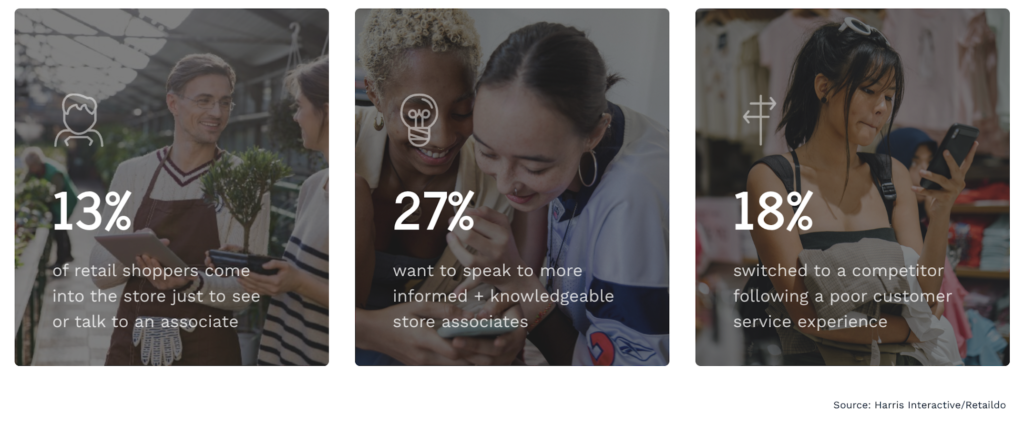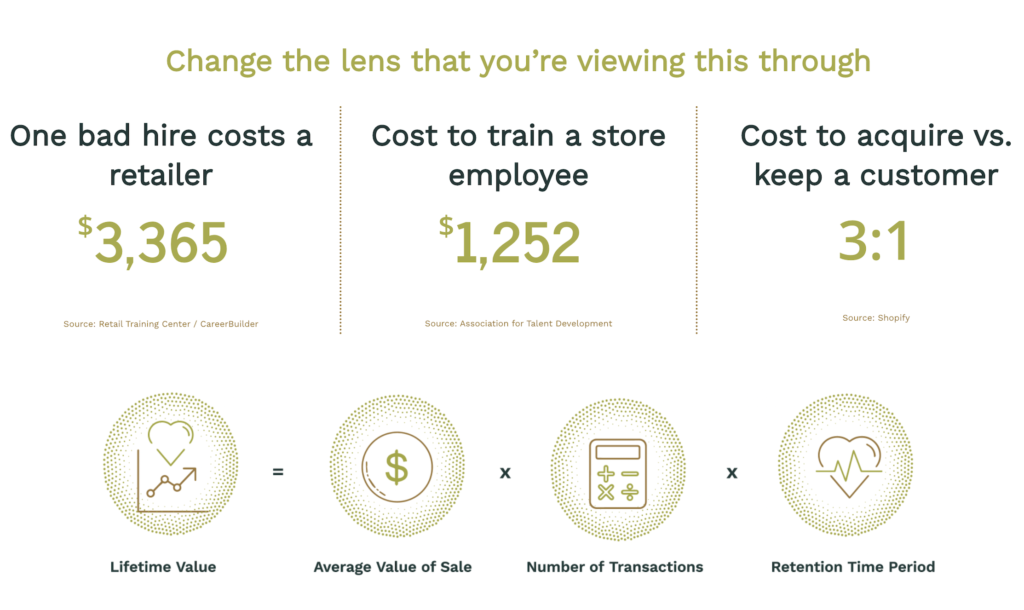ANY RETAILERS THRIVING today deserve a lot of credit. They’ve taken on a host of challenges and are coming out the other end stronger and wiser. They’re now better at handling inventory, leaner with operations and have started to figure out “unified” commerce. Most have also leaned into dynamic pricing and some have started experimenting with new platforms to help them do more with less – at least from an operational lens. Though some companies can’t say that they thrived throughout the past several years, they survived with a master’s degree in adaptability.
As challenging as the retail landscape may still be, there’s one factor that has the potential to do damage to even the most bulletproof brands, and that’s delivering poor customer experiences. Associates are the main contributor to the customer experience. Never before has finding, retaining and maximizing great people on the store floor been more difficult or more important.
Empower Associates
Store staff members are officially drawing a line in the sand. Both sentiment and statistics are pointing to the irrefutable fact that workers don’t want these jobs anymore. Pre-Covid, staffing was already one of every retailer’s biggest challenges, and presently (according to TeamStage and The U.S. Bureau of Labor Statistics), it’s not getting any easier:
- 37% of polled retail workers want to quit their jobs;
- 27% of retailers identify turnover as their biggest problem;
- Retail’s turnover rate is 60.5%;
- There are 1 million unfilled retail jobs in the U.S.;
- 50% of all retail workers left their jobs in 2021.
To attract and retain associates, retailers must rethink the problem and incorporate technology solutions that not only improve the employee experience, but also enhance the customer experience. Technology acts as a force multiplier, enabling stores to deliver better experiences with fewer associates who are now engaged and empowered to learn new skills and grow their careers.
Help Disillusioned Shoppers
The entire notion of a retail store is that of a collaborative social experience. It harkens back to the town village where everyone gathers to buy goods. A store is multisensory, it is about sight, sound, light and motion. Done well, it’s almost theatrical in the experience it provides, with the customer both part of the audience and on the stage.
Look around and you’ll see that this doesn’t always come to life for retailers. In many cases, you can take a photo of their store, pop it into a black and white filter and compare it to the exact snapshot from 1977. Chances are that it’s not that different, and shoppers know it. They’re OK with this if the help is always great and on hand, but when they are hard to find or missing, it’s a big problem.
Advertisement

Build Emotional, Digitally Enabled Relationships
If someone told you that you now have to run your retail store with 40 percent less staff and not lose revenue, close stores or increase shrink, what would you do?
When it comes down to it, we have to get people who shop our stores to come in more often and buy more when they do. Shoppers often want associates to help them do it, but when they encounter a bad one, the cost can be enormous.
The problem is that our retail model was built for human intervention. They oversee so many functions, and shoppers rely on them. But what is a retailer to do if they can’t find, hire and retain employees? New iterations of in-store digital can help.
If you do the math considering the cost to train (and lose) an associate and the cost to acquire (and lose) a customer, the ROI equations for funding in-store digital is fairly easy, especially for high ticket or complex categories.
As a society, we’ve embraced interaction with screens and tools to do things that paid workers have historically been responsible for. Think about getting a Happy Meal or a boarding pass at the airport. It’s no longer a problem to do it via a touchscreen, it’s becoming culturally okay. For retailers to navigate the associate shortage issue, they can take advantage of this.
The tools retailers can use can help guests shop, decide what to buy and then purchase in a frictionless way. They include:
Advertisement

Regarding the roles they can serve, just think about the tasks that make sense through the shopper’s journey. They can help shoppers find what they are looking for (both product and place in the store), determine if the product is right for them and help them check out without a hassle. All of them are rooted in enhancing the experience.
For associates, digital can be used to replace the operational tasks while enabling them to better serve the shopper, motivate them to close more and/or reward them for doing it.
Find the Formulas that Fit
Technology is easy to train, doesn’t call in sick, and is always available and ready. Within the sacred ground of the store, if we sublimate low skill/high functions with automation, it’s critical to do it without sacrificing the store experience.
A few simple rules:
- Use good strategy to make the experience more human, not less
- Make opt-in easy
- Find a way to make user authentication possible
- Cross the digital divide between channels and devices to ensure a seamless shopper journey
- Offer upsell/cross sell options based on previous path points and preferences
Here’s a simple example of this approach done well: Tasha is on a quest for the perfect LBD (little black dress). She comes into the store and stares at a sea of them. Undaunted, she opens up her app, taps it on an entry screen and the app opens up the options she’s saved while waiting at the car wash that morning. Up comes the location of three that may be just perfect, and off she goes to the department displayed to try them on. She gets a little lost at the elevator, so the app highlights her location and where to go to find the floor area she’s looking for. Knowing what dresses she’s looking at, it also recommends accessory looks by style profile.
Advertisement
We need to be able to capture information from browsers and shoppers with touchpoints that are fun, lightweight and can help empower their shopping path while limiting associate engagements to those that will have the most value. This has been the promise for quite some time, and while it sounds great, it’s been tough to make it fun.
But if we don’t, how will we ever transform the store from a place built for transactions to one built for developing sustainable relationships? Especially with less staff on the floor?

In-store digital is no longer “can we” or “should we,” it’s “why aren’t we?”

 Photo Gallery1 week ago
Photo Gallery1 week ago
 Headlines4 days ago
Headlines4 days ago
 Headlines1 week ago
Headlines1 week ago
 Headlines2 weeks ago
Headlines2 weeks ago
 Headlines1 week ago
Headlines1 week ago
 Designer Dozen1 week ago
Designer Dozen1 week ago
 Headlines1 week ago
Headlines1 week ago
 Headlines1 week ago
Headlines1 week ago






















